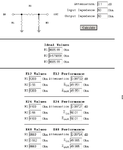neazoi
Advanced Member level 6
Hello, this spectrum analyzer has a 50R input resistor.
I wonder, why is it needed?
The input filter is designed for 50R but why is the resistor needed?
Second question is, I have designed a 50R step attenuator, that will be placed at the input of the spectrum analyzer. Do I need to include the 50R resistor and where?
At the input of the attenuator (input of the analyzer), or at the output of the attenuator, or at both the input and the output of the attenuator?
I wonder, why is it needed?
The input filter is designed for 50R but why is the resistor needed?
Second question is, I have designed a 50R step attenuator, that will be placed at the input of the spectrum analyzer. Do I need to include the 50R resistor and where?
At the input of the attenuator (input of the analyzer), or at the output of the attenuator, or at both the input and the output of the attenuator?

